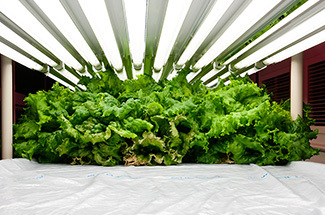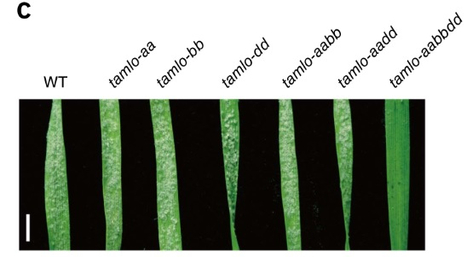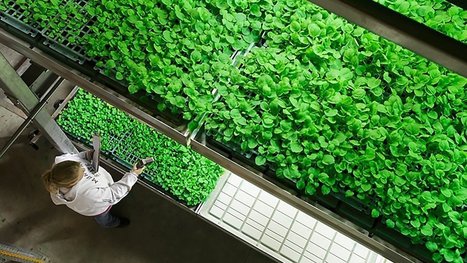 Your new post is loading...
 Your new post is loading...

|
Rescooped by
Ed Rybicki
from Top Selling Monoclonal Antibodies
August 20, 2014 7:31 AM
|
Yahoo News 'Plantibodies' drugs advance as big pharma stands aside Yahoo News There are around 30 antibody-based drugs on the market in the United States - including blockbuster cancer therapies such as Avastin and Rituxan, both from Roche Holding...
Via Krishan Maggon

|
Rescooped by
Ed Rybicki
from Ag Biotech News
August 20, 2014 7:28 AM
|
This paper exploreswhether crop genetic engineering can contribute to addressing food security, as well as enhancing human nutrition and farming under a changing climate. The review is based on peer-refereed literature, using results to determine the potential of this gene technology. It also provides a brief summary of issues surrounding this genetic enhancement approach to plant breeding, and the impacts on farming, livelihoods, and the environment achieved so far. The genetic engineering pipeline looks promising, particularly for adapting more nutritious, input-efficient crops in the development of the world’s farming systems... Although the technologies demonstrate potential to reduce crop losses, food waste, and enhance nutritional quality... farmers’ surveys reveal that increased yields are among the benefits for growing transgenic crops. Such a finding results from yield increases because of reduced losses from insect pests and weeds. In most developing countries, crop yields are low and yield gaps are large because of low input use, poor soil health, and pests and diseases. Genetic engineering has a lot promise in increasing overall adaptive capacity of agriculture but emphasis on good agricultural practices, including maintenance of soil, water, and genetic resources and increasing irrigation and fertilizers remains critical to increasing production... Given that current trends in yield increase are insufficient to double food production by 2050 and keep up with population and shifting consumption patterns, new approaches to the problem are needed. Transgenic cultivars could be a piece of that puzzle, building on success stories such as that of WEMA, but it is crucial that safety concerns are adequately addressed. Further research should benchmark conventional approaches to crop improvement, compare them with likely yield increases available from transgenic approaches, and explicitly address climate impacts to ascertain the true potential of transgenic technologies in adapting to and mitigating climate change in the long term. https://www.results.waterandfood.org/bitstream/handle/10568/41934/CCAFS%20WP%2072.pdf
Via Alexander J. Stein

|
Scooped by
Ed Rybicki
August 18, 2014 7:59 AM
|
The National Institute of Advanced Industrial Science and Technology, Hokkaidō, has developed a state-of-the-art plant factory that is the first in the world equipped to cultivate transgenic plants and convert them into drugs, all on the same premises.

|
Scooped by
Ed Rybicki
August 14, 2014 2:34 AM
|
"Here is what I said about the ebola antibody system on Arizona TV last night. I hope you approve!"

|
Rescooped by
Ed Rybicki
from Virology News
August 12, 2014 5:32 AM
|
All three US facilities established to quickly make vaccines and therapeutics in the event of a major public health threat say they are standing by to support any US government effort to scale up a treatment for Ebola.

|
Rescooped by
Ed Rybicki
from Virology News
August 8, 2014 5:32 AM
|
US tells Nigeria region would have to wait months for supplies because such small quantities exist, says health minister

|
Scooped by
Ed Rybicki
August 7, 2014 3:19 AM
|
Medical Ethicist Harriet Washington wrote in a CNN op-ed the Ebola serum should be mass-produced and given to Africans.

|
Scooped by
Ed Rybicki
August 6, 2014 3:03 PM
|
Plans for a new £5m molecular farming facility furthering ground-breaking technologies invented at the John Innes Centre in Norwich were announced on 23rd July 2014. The announcement was made by Professor Jackie Hunter, BBSRC Chief Executive, at an event marking the opening of the landmark new Centrum building on the Norwich Research Park. The new facility will use a technology invented by Professor George Lomonossoff and Dr Frank Sainsbury, BBSRC Innovators of the Year in 2012, and will establish Norwich as a leading international centre for research and development in the use of plants to produce high value compounds. The technology is already in use in Canada, where pharmaceutical company Medicago has a greenhouse of plants on permanent readiness to be able to produce vast quantities of vaccine in the event of a pandemic flu - the technology has meant it is possible to now produce 10m doses of a vaccine in 30 days compared with 9 months using traditional methods. The announcement formed part of the official opening of the Centrum building on the Norwich Research Park, by the Minister for Life Sciences George Freeman. Mr Freeman also launched the Norwich Research Park’s Virtual Technology Centre – a website which enables ease of access for academics and businesses, to the wealth of scientific technology platforms at the John Innes Centre and other institutes across the Norwich Research Park

|
Scooped by
Ed Rybicki
August 6, 2014 1:42 PM
|
The “secret serum” being used to treat the two Americans infected with Ebola virus is a three-monoclonal-antibody experimental cocktail provided by Mapp Biopharmaceutical.

|
Scooped by
Ed Rybicki
August 5, 2014 12:21 PM
|
ZMapp is made of three monoclonal antibodies, disease fighting proteins that target a specific part of an invading pathogen, in this case the Ebola Zaire virus. That is the specific strain of Ebola responsible for this outbreak. Two of the monoclonal antibodies are the product of years of research done at the Public Health Agency of Canada's National Microbiology Laboratory in Winnipeg, the agency confirmed in an email late Monday. The drug is generated in tobacco plants that have been genetically engineered to produce the monoclonal antibodies. That work is done by Kentucky BioProcessing of Owensboro, KY., a subsidiary of tobacco giant Reynolds American. A spokesman for Reynolds said within the last week Kentucky BioProcessing was asked by Emory University Hospital and Samaritan's Purse to provide a limited amount of ZMapp to be used to treat Brantly and Writebol. David Howard said the makers were given an IND — investigational new drug — designation by the U.S. Food and Drug Administration.

|
Rescooped by
Ed Rybicki
from Plants and Microbes
July 23, 2014 2:55 AM
|
Sequence-specific nucleases have been applied toengineer targeted modifications in polyploid genomes, but simultaneous modification of multiple homoeoalleles has not been reported. Here we use transcription activator–like effector nuclease (TALEN) and clustered, regularly interspaced, short palindromic repeats (CRISPR)-Cas9 technologies in hexaploid bread wheat to introduce targeted mutations in the three homoeoalleles that encode MILDEW- RESISTANCE LOCUS (MLO) proteins. Genetic redundancy has prevented evaluation of whether mutation of all three MLO alleles in bread wheat might confer resistance to powdery mildew, a trait not found in natural populations. We show that TALEN-induced mutation of all three TaMLO homoeologs in the same plant confers heritable broad-spectrum resistanceto powdery mildew. We further use CRISPR-Cas9 technologyto generate transgenic wheat plants that carry mutations inthe TaMLO-A1 allele. We also demonstrate the feasibility of engineering targeted DNA insertion in bread wheat through nonhomologous end joining of the double-strand breaks caused by TALENs. Our findings provide a methodological framework to improve polyploid crops.
Via dromius, Kamoun Lab @ TSL
Covering: up to 2014 In silico approaches have been widely recognised to be useful for drug discovery. Here, we consider the significance of available databases of medicinal plants and chemo- and bioinformatics tools for in silico drug discovery beyond the traditional use of folk medicines. This review contains a practical example of the application of combined chemo- and bioinformatics methods to study pleiotropic therapeutic effects (known and novel) of 50 medicinal plants from Traditional Indian Medicine. Alexey A. Lagunin, Rajesh K. Goel, Dinesh Y. Gawande, Priynka Pahwa, Tatyana A. Gloriozova, Alexander V. Dmitriev, Sergey M. Ivanov, Anastassia V. Rudik, Varvara I. Konova, Pavel V. Pogodin, Dmitry S. Druzhilovsky and Vladimir V. Poroikov Nat. Prod. Rep., 2014, Advance Article DOI: 10.1039/C4NP00068D Received 23 May 2014, First published online 22 Jul 2014
Via NatProdChem

|
Scooped by
Ed Rybicki
July 15, 2014 10:39 AM
|
Numerous monoclonal antibodies (MAbs) that recognize and neutralize infectious pathogens have been isolated and developed over the years. The fact that infectious diseases can involve large populations of infected individuals is an important factor that has motivated the search for both cost-effective and scalable methods of antibody production. The current technologies for production of antibodies in plants allow for very rapid expression and evaluation that can also be readily scaled for multikilogram production runs. In addition, recent progress in manipulating glycosylation in plant production systems has allowed for the evaluation of antibodies containing glycans that are nearly homogeneous, are mammalian in structure, and have enhanced neutralizing capabilities. Among the anti-infectious disease antibodies that have been produced in plants are included those intended for prevention or treatment of anthrax, Clostridium perfringens, Ebola virus, human immunodeficiency virus, herpes simplex virus, rabies, respiratory syncytial virus, staphylococcal enterotoxin, West Nile virus, and tooth decay. Animal and human efficacy data for these MAbs are discussed.
|

|
Scooped by
Ed Rybicki
August 20, 2014 7:30 AM
|
Guardian Liberty Voice New Type of Plant Communication Discovered: RNA Transfer Between Plants Guardian Liberty Voice Much has been learned about plant communication in the last few decades but a new type of plant communication was discovered...

|
Scooped by
Ed Rybicki
August 20, 2014 7:09 AM
|
Genetic editing allows for modifying fruit without having to insert foreign genes. Consumers can soon eat vitamin-enriched bananas or apples that do not turn brown on exposure without having to check for GM labels. Advances in precise editing of fruit genomes promise that, says a Science Daily report, quoting the journal Trends in Biotechnology. Genetic editing could be the next big thing in the world of biotechnology research. In fact, GEOs or genetically edited organisms could be the natural step to sustainable agriculture, according to a scientist, Chidananda Nagamangala Kanchiswamy of Istituto Agrario San Michele in Italy. New tools allow scientists to make minute alterations to the DNA of a fruit and obtain major changes. This could involve deletion or altering of existing genes, sometimes just switching on or off a gene.

|
Scooped by
Ed Rybicki
August 18, 2014 3:47 AM
|
iBio Forms Marketing Collaboration With Kanematsu Chemicals Corporation to Target Japanese Market NEWARK, DE - August 14, 2014 - iBio, Inc. (NYSE MKT: IBIO), and Kanematsu Chemicals Corporation, part of Kanematsu Corporation (8020:TOKYO), have entered into a collaboration agreement under which Kanematsu Chemicals Corporation will market the novel iBioLaunchTM platform in Japan. The collaboration combines iBio's plant-based expression system and expertise for rapid, reliable and economical development and production of biological vaccines and therapeutics, with the marketing reach and regional expertise of the life science group from Kanematsu Chemicals Corporation.

|
Scooped by
Ed Rybicki
August 13, 2014 10:07 AM
|
Supplies are limited, and deciding who gets treatment is difficult Even as the Ebola crisis rages onward inwest Africa, a World Health Organization panel concluded on August 11 that offering patients promising experimental Ebola drugs with unknown side effects andefficacy would be ethical.
The 12-member panel from the United Nations agency left aside questions about who should get the limited drugs and how that should be decided until it meets again at the end of the month. WHO says the difference between this outbreak and the circumstances in prior episodes is the sheer scale of the affected areas, which rendered traditional public health approaches to containing Ebola inadequate.

|
Rescooped by
Ed Rybicki
from Virology News
August 8, 2014 5:32 AM
|
As the largest outbreak of Ebola virus has forced hitherto neglected tropical diseases on to the public agenda, debate is growing over whether affected patients should have the chance to try experimental drugs. Sophie Arie reports Ebola virus graphic from Russell Kightley Media

|
Scooped by
Ed Rybicki
August 7, 2014 1:02 PM
|
An experimental medicine that has been called a “secret serum” is being given to two Americans infected with Ebola. How and why Dr. Brantly and Ms. Writebol received the drug, ZMapp, is one of the many mysteries surrounding what has been called a “secret serum,” including the big one: Does it really work? The Americans are the only two patients who have been treated with the medicine, out of perhaps thousands who might have benefited so far, raising old questions about who does — and does not — have access to medications, including experimental drugs. But the San Diego-based Mapp Biopharmaceutical, the primary developer of the drug, was consumed Wednesday with how to manufacture more of it with an eye to providing the drug to more patients, probably in the form of clinical trials.

|
Scooped by
Ed Rybicki
August 7, 2014 3:16 AM
|
AC360 looks into the ethical questions surrounding the treatment of two Americans who are battling Ebola.

|
Scooped by
Ed Rybicki
August 6, 2014 2:29 PM
|
CNN's Stephanie Elam investigates the serum called ZMapp, administered to the American Ebola patients.

|
Scooped by
Ed Rybicki
August 5, 2014 2:18 PM
|
Yes, I know you fans of ViroBlogy like Ebola - and just coincidentally, I was desperately trying to finish a review on "Plant-based vaccines against viruses" against a backdrop of an out-of-control...

|
Scooped by
Ed Rybicki
July 23, 2014 3:01 AM
|
What if farms came in from the cold and we grew our food indoors? Powered by 17,500 LED lights, a new Japanese "plant factory" is producing 10,000 heads of lettuce a day.

|
Scooped by
Ed Rybicki
July 23, 2014 2:51 AM
|
Abstract In the chloroplast, the post-transcriptional steps of gene expression are remarkably complex. RNA maturation and translation rely on a large cohort of nucleus-encoded proteins that act specifically on a single target transcript or a small set of targets. For example in the chloroplast of Chlamydomonas, trans-splicing of the two split introns of psaA requires at least fourteen nucleus-encoded proteins. To investigate the functional significance of this complex trans-splicing pathway, we have introduced an intron-less copy of psaA in the chloroplast genomes of three mutants deficient in trans-splicing and of the wild type. We find that the intron-less psaA gene rescues the mutant phenotypes. The growth of strains with the intron-less psaA is indistinguishable from the wild type under the set of different experimental conditions that were investigated. Thus thetrans-splicing factors do not appear to have any other essential function and trans-splicing of psaA can be by-passed. We discuss how these observations support the hypothesis that complex RNA metabolism in the chloroplast may in part be the result of a non-adaptive evolutionary ratchet. Genetic drift may lead to the accumulation of chloroplast mutations and the recruitment of compensatory nuclear suppressors from large pre-existing pools of genes encoding RNA-binding proteins.

|
Rescooped by
Ed Rybicki
from Digital-News on Scoop.it today
July 23, 2014 2:48 AM
|
Outer space is full of stellar and planetary beauty, but not very much man-made art. Now, 38-year-old Japanese artist Azuma Makoto has mixed art and space exploration in a special project entitled Exobiotanica. The mission involved launching two botanical objects into space: a Japanese white pine bonsai called “Shiki 1” and an untitled bouquet arrangement […]
Via Thomas Faltin
|



 Your new post is loading...
Your new post is loading...







![Ebola patients in west Africa to be denied experimental drugs used in US [because there are none left] | Plant Molecular Farming | Scoop.it](https://img.scoop.it/luso5q3CZODAM95c2Mvikjl72eJkfbmt4t8yenImKBVvK0kTmF0xjctABnaLJIm9)























